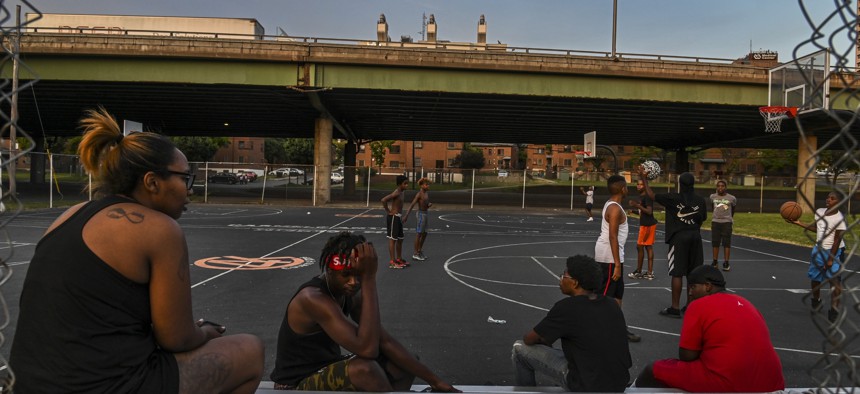Feds Launch $1B Initiative to Rework Infrastructure That Cut Apart Cities

Kids play basketball at Wilson Park near where highway I-81 slices through the public housing complex called Pioneer Homes in the south side of Syracuse, N.Y., in 2019. Jahi Chikwendiu/The Washington Post via Getty Image
The Biden administration says places that prioritize community outreach as they design project proposals will have an advantage over others.
Localities applying for federal money to reconnect neighborhoods carved apart by highways, rail lines or other infrastructure will get an edge if they consult with long-time residents, businesses and community groups, the Biden administration announced Thursday.
The details come as the administration formally opened the grant process for the Reconnecting Communities pilot program, a part of the federal infrastructure law Congress passed last year. Congress set aside $1 billion over the next five years for the effort. That’s a far cry from the $20 billion the president originally wanted for the program, but it remains a symbol of Biden’s stated vision of building infrastructure that benefits underserved communities.
“This is the first-ever dedicated federal initiative to unify neighborhoods and communities that are still impacted by infrastructure decisions of the past,” Transportation Secretary Pete Buttigieg said on a call with reporters Wednesday.
“Everywhere I go, people talk about the effect of the highway, the railway – whatever piece of infrastructure it is in their area – that has walled one part of town off from another,” he said. “Unlike a lot of other policy mistakes or problems in the past, this is something that can’t be as easily reversed.”
The Reconnecting Communities grants could help fund a variety of infrastructure projects.
Administration officials have often used the examples of removing interstates like the Claiborne Expressway in New Orleans or the Interstate 81 viaduct in Syracuse, but those efforts could easily cost billions of dollars on their own. Buttigieg and other Biden administration officials noted on Wednesday that the grants can be used for smaller projects, for planning activities and as part of a funding mix for more ambitious proposals, too.
Stephanie Pollack, the deputy administrator who runs the Federal Highway Administration, listed several possible uses, including: Better bus and rail service; pedestrian walkways over or under existing highways; parks on top of capped highways; linear parks and trails for biking and walking; commercial corridor revitalization; roadway redesigns; and “complete streets” conversions to accommodate people using different modes of transportation.
“We don’t expect this [program] by itself to pay for all very expensive projects. But the pieces of those projects that it can pay for are going to be the pieces that are most vital to the communities that are the neighbors of these projects and the hosts of these projects,” Pollack told reporters.
The initial year of funding will include $195 million in grants, of which $50 million is designated for planning activities and $145 million is set aside for construction.
The infrastructure law specifies that planning grants can be up to $2 million, but construction grants must be at least $5 million. The federal government can only cover up to half of the cost of construction for a project.
The grants are open to states, localities, tribal governments, metropolitan planning organizations, nonprofit groups and other owners of transportation facilities.
The Federal Highway Administration will judge applicants on several criteria, including:
- The historic or current harms that the project seeks to address, and how the plan proposes to address those harms
- The potential for the project to increase mobility in the community by removing barriers (including “over-reliance on automobiles”), adding options for people using active transportation or transit, and providing “better access to daily destinations like jobs, healthcare, grocery stores, schools, places of worship, recreation and parks”
- Community involvement in the development and management of the project, including formal partnerships with neighborhood organizations and the creation of a community advisory group
- Plans for sharing the benefits of the project, including measures to prevent gentrification and displacement and plans to “celebrate local history and culture through public art, greenspace, and recreational spaces for residents and visitors.”
Applications are due Oct. 13. The administration expects to announce winners early next year.
Daniel C. Vock is a senior reporter for Route Fifty based in Washington, D.C.
NEXT STORY: Police are looking to algorithms to predict domestic violence






